Evaluation of Working Health Services Scotland, 2010-2014
The Working Health Services Scotland (WHSS) was introduced to provide support to employees in small and medium sized businesses', whose health condition was affecting their ability to work.
The programme offers telephone based case management & some fac
2 Description of cases
2.1 Overview
There were a total of 13,463 referrals into the programme in the four year period. However, some individuals entered the programme more than once, so the number of unique individuals, (i.e. 'clients'), is less than the number of referrals (i.e. 'cases') (see Section 2.3.1). Throughout this evaluation, the cases are the subject of the analysis.
It should be noted that a number of variables were missing in the data records, meaning that the N value varies in the following presentation of results.
2.2 Referrals over time
The rate of referrals into the WHSS programme from 26 th March 2010 to 31 st March 2014 is shown in Figure 1. This shows the combined referral rates of self-referral (directly into the service) and via the NHS 24 MSK pilot study, including those who entered the programme more than once. The highest referral rates were in October and November 2012 and January 2013. The entry criteria for referral into WHSS via the NHS 24 MSK pilot programme were subsequently changed (February 2013) following the significant spike in referral with its introduction; this then reduced the number of referrals via this route. During the 4 year period, 19% of referrals were via the NHS 24 MSK pilot.
Figure 1: Number of WHSS referrals over the intervention period (March 2010 to March 2014).
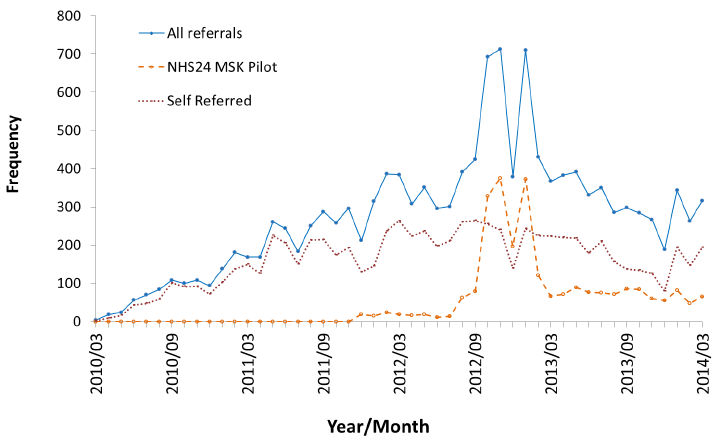
Solid blue: all referrals; dotted purple: self-referred; dashed orange: NHS 24 MSK pilot referrals.
From autumn 2013, uncertainties about future funding (beyond 2014), and the planned introduction of the Fit for Work programme may have confused some referrers, and led to lower referral rates in the last few months of the evaluation period.
The three Boards that had participated in the WHSS pilot maintained their own records until at least April 2011, and these records are not included in this analysis. This analysis includes cases from Dundee & Tayside enrolled after 31 st March 2011; from Borders enrolled after 11 th April 2011 and from Lothian enrolled after 16 th October 2011.
2.3 Completion of assessments
Altogether 13,463 cases completed the enrolment assessment. Of these, 1,715 (12.7%) did not complete the entry assessment; the reasons for this are given in Table 1. The most common reasons are the cases being re-routed to a more appropriate service (33%); the service not being able to contact the client (25%) and the client voluntarily withdrawing from the service (16%). Reasons cases were not eligible included that they did not work for an SME, they did not live in the eligible geographical area, or for those coming through the MSK pathway, that they were not absent from work.
Table 1: Reasons for cases not completing the entry assessment (N=1,715)
| Reroute to more appropriate service |
32.7% |
|---|---|
| Unable to contact |
25.0% |
| Voluntary withdrawal |
16.3% |
| Not eligible |
11.1% |
| Being seen elsewhere |
8.9% |
| Unknown |
3.4% |
| Duplicate - already on system |
2.5% |
| Back to work |
0.1% |
There were therefore 11,748 cases (87.3% of those who enrolled) that completed the entry assessment. Of these, 4,787 (40.7%) did not complete the discharge paperwork, although they were discharged from the service. The reasons for not completing the paperwork are shown in Table 2. The most frequently reported reasons were that the service was not able to contact the client (60%); clients voluntary withdrawing from the programme (15%); or not attending appointments (5%).
Table 2: Reasons for not completing discharge paperwork (N=4,726)
| Unable to contact |
60.1% |
|---|---|
| Voluntary withdrawal |
14.6% |
| No reason given |
14.2% |
| Did not attend appointments |
5.1% |
| Receiving treatment elsewhere / referred elsewhere |
3.7% |
| Other health condition / health condition worsened |
0.6% |
| No longer eligible |
0.5% |
| Not appropriate referral |
0.4% |
| Other |
0.7% |
This means that discharge paperwork is available for 7,022 cases. All of these had completed at least some part of the discharge paperwork. However, 1,432 did not complete the discharge EQ-5D; there are 5,590 cases for which both entry and discharge EQ-5D are available. This includes 37 cases who were recorded as being discharged as unable to contact, 16 who voluntary withdraw and 4 who were no longer eligible for the service. This is summarised in Figure 2.
Figure 2: Number of cases who completed different parts of the programme
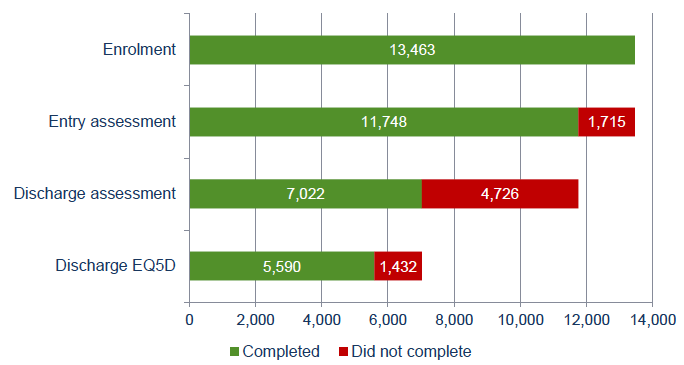
2.4 Demographics of cases
2.4.1 Health Board
Lanarkshire Health Board had the highest proportion (26%) of cases enrolling in the programme, with 3,554 cases (Figure 3). It should be noted that because Lanarkshire (Salus) were managing the national implementation of the programme, they took on case management from some Boards where the local case manager was absent; two Boards (Greater Glasgow & Clyde and Highland) also contracted their services to Lanarkshire partway through the evaluation period. Due to the constraints of the database, the cases that were referred to Lanarkshire in this way are recorded as Lanarkshire cases, which partly accounts for the high proportion of cases seen by Lanarkshire.
Dundee & Tayside, and Lothian follow with 2,601 (19%) and 2,207 (16%) cases enrolled respectively (Figure 3). Dundee & Tayside, Lothian, and Borders all participated in the pilot of WHSS, and were therefore established services when this period of data collection began. However data from these services prior to April 2011 (Dundee & Tayside, and Borders) and October 2011 (Lothian) isn't included in this evaluation, implying that they saw a greater number of cases over the 4 year period. The evaluation of this pilot programme (Hanson et al, 2011) showed that these Boards were receiving an average of between 23 and 28 cases per month (between 2008 and 2010). Assuming the referral rates remained the same, Borders may have enrolled approximately an additional 280 cases (in 12 months); Dundee approximately an additional 330 cases (in 12 months), and Lothian approximately an additional 470 cases (in 19 months) before recording on the WHSS database.
Some Health Boards cover a larger population than others, and the number of eligible adults (employed in an SME) within each Board area is not known. It is therefore not possible to say how well Boards recruited from their available potential clients.
2.4.2 New or repeat referral
Of the 11,685 cases for which data are available about whether they had used WHSS previously, 92% were new referrals into the service; 5% were referring again with a new health condition; and 3% were referring again with the same health condition.
Considering repeat referrals by Health Board, the greatest number came from Dundee & Tayside, where 266 (10%) of their 2,601 clients re-entered the programme (green section of bar). Although the numbers are lower, the greatest proportion of re-entries for a Health Board was in Borders, where 106 (14%) of their 760 clients entered more than once. In Greater Glasgow & Clyde, 59 (11%) of their 541 clients re-entered WHSS (see Figure 3). The blue section of the bar represents cases that entered once, while the green represents those who entered more than once.
Overall 7% of females and 6% of males re-entered the programme. Those who were older were more likely to re-enter (3% of those who were under 30 re-entered; 6% of those who were 30-39; and 8% both of those who were 40-49 and over 50).
Figure 3: Percentage of WHSS cases by Health Boards. The percentage shown is the total percentage of the whole sample which came from each Board area. (N=13,462)
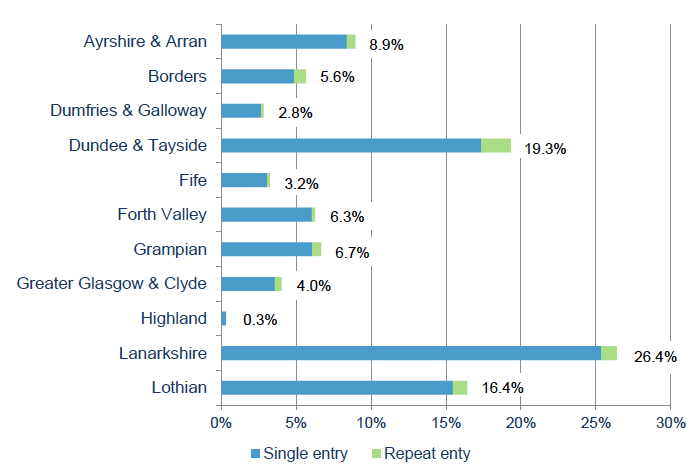
Figure 4 shows the differences between Boards in the completion of the entry paperwork.
Figure 4: Proportion of cases from each Board who completed the entry assessment
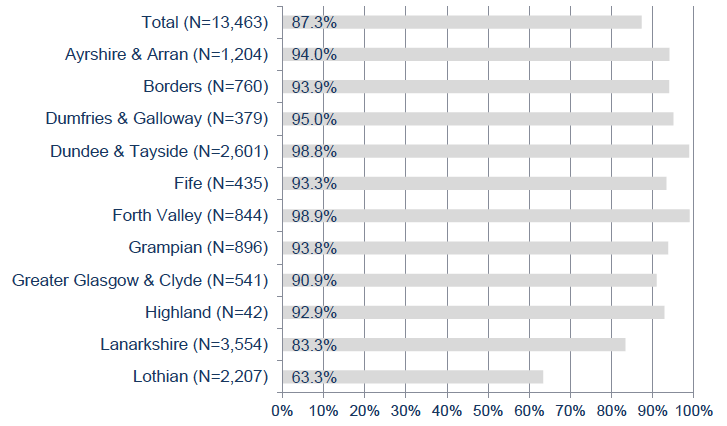
Most Boards had more than 80% of their enrolled cases entering into the programme (completing the entry assessment). Lothian had a lower proportion (63%), which is thought to be due to their way of promoting the service, whereby referrers ( GPs and employers) were encouraged to advise anyone with a need to refer into the service, and the service then screened them for eligibility, routing them elsewhere if required.
2.4.3 SIMD category
In order to evaluate any inequality in socioeconomic status of those referred, SIMD categories were calculated, and the number of cases from each SIMD quintile is shown in Figure 5. The number of cases increases with SIMD category (i.e. the less deprived clients). This is statistically significant (p=0.007, correlation value r=0.97).
Figure 5: Percentage of WHSS cases based by SIMD quintile deprivation rank (1: most deprived and 5: least deprived) (N=13,461)
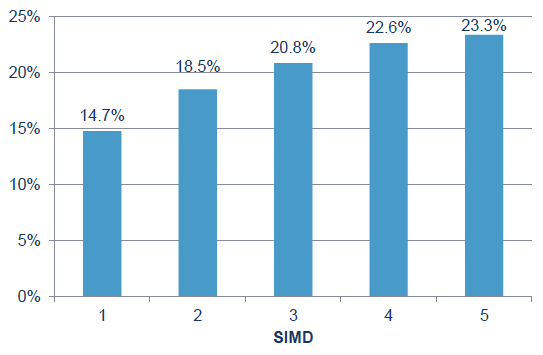
It should be noted that employment is not equally distributed across the SIMD quintiles, with approximately 28% of working aged people "employment deprived" [2] in SIMD 1, 17% in SIMD 2, 11% in SIMD 3, 7% in SIMD 4 and 4% in SIMD 5 (The Scottish Government, 2012).
Trying to establish whether there are inequalities in access to WHSS due to SIMD is difficult, as deprivation is not equally distributed across Scotland, the number of cases who entered the programme from different areas was different, and the proportion of those in employment in SMEs across the different regions in Scotland is not known. However, 25% of WHSS cases are from Dundee and Tayside and Ayrshire and Arran which include 2 of the 5 highest areas of deprivation in Scotland (North Ayrshire and Dundee City). The remaining 3 areas of highest deprivation, Glasgow City, Inverclyde, West Dunbartonshire, fall within Greater Glasgow & Clyde, which makes up 4% of the sample.
Considering the proportion of the sample which came from different SIMD quintiles, and comparing that with the proportion of that quintile which is not employment deprived shows that a greater proportion of those in higher SIMD accessed WHSS than those in lower SIMD. It is estimated that 0.42% of all those in employment (i.e. those employed in large organisations, SMEs and the self-employed) in SIMD 1 used WHSS; 0.45% of those in SIMD 2; 0.48% of those in SIMD 3, and 0.50% of those in SIMD 4 and 5. (Note that this is based on cases which could include the same client entering the programme more than once). It is possible that the increased use of the service by the less deprived is an example of the "inverse care law" i.e., those that access services may not be in the greatest need.
Summary demographic information for cases is presented in Table 3, for those who completed the entry assessment, and are shown across the SIMD quintiles. This shows that these demographic data are relatively similar across the SIMD quintiles, with the exception of age and absence status at entry.
2.4.4 Ethnicity
Of those who provided their ethnicity (10,994), the majority of cases, 9,275 (84%), were white Scottish, with the total proportion of cases who were white being 96.3%, and 3.7% being non-white. This is broadly in line with national data on ethnicity and employment which shows that 97% of those employed in Scotland in 2011-14 are white, while 3% are non-white (The Office of National Statistics, 2015).
2.4.5 Age
The average age of cases in the whole sample (N=13,463) is 45 ( SD 12) years old with the youngest being 16 years and oldest being 88 years. Altogether 43% of the cases were over 50-year-old, while only 10% are under 30. Cases aged 30 to 49 year-old account for 47% of the sample (see Figure 6). Note that this includes repeat entries.
These data can broadly be compared with data on employment from the Scottish Government (Scottish Government, 2014), although the age categories used are different in Scottish Government figures. However, approximately 35% of the Scottish workforce is between 16 and 35; 35% is between 35 and 49, and 31% is over 50. While almost a third of the Scottish workforce is over 50, 43% of referrals into the programme were over 50, indicating a greater proportion of older workers referring in to WHSS. This is to be expected, as it is known that, generally, health needs increase with age (Naessens et al, 2011).
Cases with Mental Health ( MH) conditions are on average younger (42 [ SD 11] years) than cases with musculoskeletal ( MSK) conditions (45 [ SD 12] years).
The average age of cases differs significantly among the SIMD groups (p<0.0001), with average age going up with increasing SIMD (i.e. those in more deprived categories are younger (Table 3).
The percentage of each age group who entered the programme more than once goes up with increasing age, with 3.3% of those aged less than 30 re-entering the programme; 6% of those aged 30-39; 7.6% of those aged 40-49; and 7.6% of those aged over 50.
Table 3: Demographic details at entry by SIMD quintiles
| Cases pre-intervention |
SIMD quintiles |
Whole sample |
||||
|---|---|---|---|---|---|---|
| 1 |
2 |
3 |
4 |
5 |
||
| Number |
1,718 |
2,228 |
2,467 |
2,626 |
2,709 |
11,748 |
| Age |
||||||
| Average age ( SD) (years) |
43.3 (12) |
43.5 (12) |
44.6 (12) |
45.7 (12) |
45.4 (12) |
44.6 (12) |
| Gender |
||||||
| Female (%) |
49 |
47 |
49 |
48 |
48 |
48 |
| Male (%) |
50 |
52 |
50 |
51 |
51 |
51 |
| Missing / not specified (%) |
0.4 |
0.8 |
0.5 |
0.7 |
0.8 |
0.6 |
| Primary health condition |
||||||
| MSK (%) |
85 |
83 |
83 |
85 |
85 |
84 |
| MH (%) |
12 |
14 |
13 |
11 |
11 |
12 |
| Other (%) |
3 |
3 |
4 |
4 |
4 |
4 |
| Employment status |
||||||
| Full time (%) |
74 |
77 |
75 |
78 |
75 |
76 |
| Part time (%) |
26 |
23 |
25 |
22 |
25 |
24 |
| Absence status |
||||||
| Off sick at entry (%) |
24 |
22 |
22 |
21 |
19 |
21 |
2.4.6 Gender
Just under half (49%) of enrolled cases were women (6,522) while 6,853 were male, and this proportion is maintained across the age groups and SIMD groups (Table 3). This appears to broadly reflect employment rates for men and women, with slightly more men (75.0%) being employed during the period of the study, than women (67.3%) (The Scottish Government, 2014 [3] ).
Figure 6: Percentage of cases by gender for each age group (N=13,375)
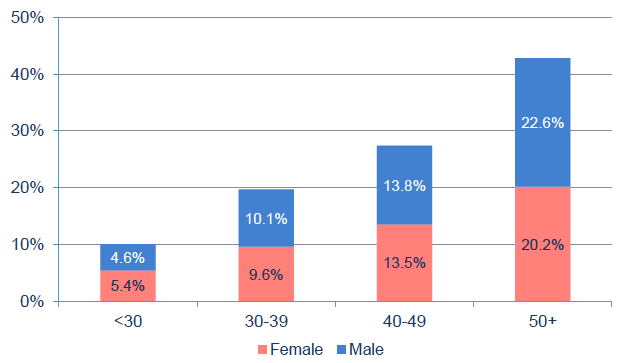
There is no significant gender difference between SIMD groups or age groups. The greatest proportion of cases is men over 50 (Figure 6).
There was no significant difference between the number of men and women re-entering the programme, with 6% of men and 7% of women entering WHSS more than once.
2.4.7 Standard Occupational Code
The Standard Occupational Code ( SOC) was used to categorise cases into the 9 SOC categories (see Table 4). The greatest proportion of cases (21%) came from SOC 5, the skilled trades occupations, which includes agriculture, electrical / electronic trades, and construction and building trades. The smallest proportion (7%) came from SOC 8 Process, plant and machine operatives (which includes drivers and transport operatives) and SOC 9, elemental occupations, which includes elementary trades and elementary administration and service occupations.
Table 4: Standard Occupational Classification ( SOC) [from the Office for National Statistics]
| Standard Occupational Classification |
% of respondents (N=8,455) |
|---|---|
| SOC 1: Managers, directors and senior officials |
8.6% |
| SOC 2: Professional occupations |
11.9% |
| SOC 3: Associate professional and technical occupations |
9.5% |
| SOC 4: Administrative and secretarial occupations |
11.6% |
| SOC 5: Skilled trades occupations |
21.1% |
| SOC 6: Caring, leisure and other service occupations |
10.9% |
| SOC 7: Sales and customer service occupations |
12.4% |
| SOC 8: Process, plant and machine operatives |
6.8% |
| SOC 9: Elementary occupations |
7.4% |
2.4.8 Size of employer
Figure 7 shows that the greatest proportion of cases (30%) came from employers between 11 and 50 employees, while almost 20% were self-employed. Altogether, just over three quarters (76%) came from organisations with 50 or fewer employees.
Figure 7: Showing the percentage of cases drawn from different sizes of employers (N=11,608)
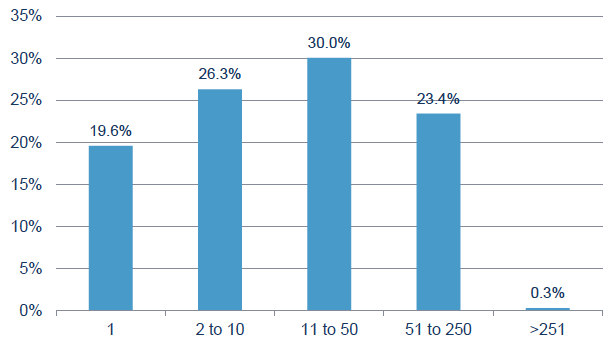
Thirty cases reported to be from non- SMEs (with more than 250 employees); these cases did not meet the WHSS eligibility criteria, but were accepted in a small number of cases.
2.4.9 How cases referred into the programme
The means by which cases referred into the programme is shown in Table 5.
Table 5: The means by which cases referred into the programme (N=13,463)
| Self |
58.7% |
|---|---|
| NHS 24 MSK Pilot |
19.3% |
| GP |
10.9% |
| Health professional / AHP |
5.2% |
| Other |
1.9% |
| Line manager / employer |
1.3% |
| NHS physiotherapy waiting list |
1.2% |
| Other / unknown |
1.4% |
The majority of cases (59%) self-referred into the programme. However, 19.3% (2,594 cases) were referred through the NHS 24 MSK Pilot; furthermore, some Boards worked closely with their local NHS physiotherapy service and either received cases via health professional / AHPs (5.2%) or from NHS physiotherapy waiting lists (1.2%). These sources of referral will have increased the number of MSK cases in the programme. There were no similar routes for identifying potential cases with a mental health condition, which may partly account for the higher proportion of cases with a MSK condition than with a mental health condition.
2.4.10 Primary health condition
Cases' primary reason for referring into WHSS is shown in Figure 8.
Figure 8: Primary health condition of cases (N=11,745)
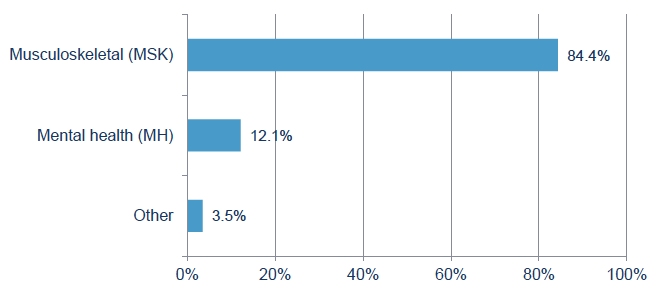
The majority of cases have referred due to a musculoskeletal condition ( MSK) (84%); while 12% have referred with a mental health ( MH) condition (depression, stress, anxiety and other mental health conditions). All other health conditions are categorised as 'Other' for this analysis and account for 4% of cases. Hereafter, the analysis will be focused on MSK and MH cases, as they comprise 96% of all cases.
There is an association between deprivation ( SIMD) and the primary condition (p=0.04); cases in SIMD 2 and 3 are 1.2 and 1.1 times more likely, respectively, to have MH as their primary condition compared to cases in SIMD 5 (least deprived).
Type of occupation was also associated with the primary condition of cases (p<0.0001); all occupations have higher risks of MH conditions compared to SOC 5 (skilled trades occupations), with the associate professional and technical occupations group ( SOC 3) having the highest risk overall, being just over 3 times more at risk of MH conditions compared to cases in SOC 5.
There is also a strong association between gender and primary condition (p<0.0001); women are twice as likely as men to have a MH condition ( RR= 2.00, 95% CI [1.81, 2.22]) (Figure 9).
Figure 9: Proportion of men and women experiencing MSK or mental health conditions at entry (N=11,317). Those with 'other' health conditions are not shown (3.5% of the population, evenly divided between male and female).
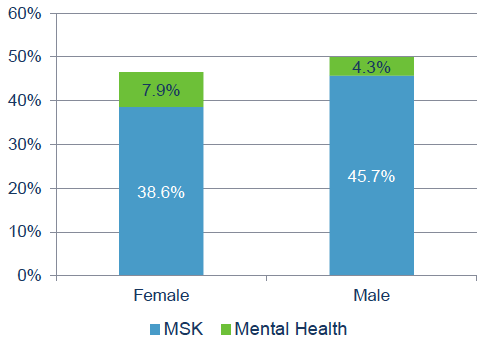
2.4.11 Secondary health condition
Altogether, 2,154 of cases (16%) also reported a secondary health condition, for which they may have received treatment / support while in the WHSS programme. Almost a quarter (24%) of those with a MH condition had a secondary health condition (most commonly another MH condition), while 15% of those with an MSK had a secondary condition (most commonly another MSK). This is shown in Table 6.
Table 6: Secondary health conditions of cases
| Primary health condition |
Secondary health condition |
|||
|---|---|---|---|---|
| MSK |
MH |
Other |
Total |
|
| MSK (N=9,935) |
9% |
4% |
3% |
15% |
| MH (N=1,434) |
6% |
14% |
4% |
24% |
2.4.12 Absence status at entry
Altogether 2,902 cases (24.7%) were absent at entry with 8,843 (75.3%) being at work (N=11,745).
Considering absence by primary health condition shows that 21.4% of MSK cases were absent at entry (N=9,934), while almost twice as many (41.1%) of MH cases were absent (N=1,434) (Table 7).
Table 7: Absence status at entry by primary health condition
| MSK cases |
MH cases |
|||
|---|---|---|---|---|
| N |
% |
N |
% |
|
| Off sick at entry |
2,125 |
21.4% |
590 |
41.1% |
| At work at entry |
7,809 |
78.6% |
844 |
58.9% |
| Total |
9,934 |
100.0% |
1,434 |
100.0% |
2.4.13 Duration of absence at entry
A total of 2,145 cases who were absent from work at their entry assessment provided information on how long they had been absent up to that point. Of these, 36% (776 cases) had been absent for no longer than 2 weeks at the time of their entry assessment, while 20% (438 cases) had been absent for more than 12 weeks (Figure 10).
Figure 10: Percentage and number of WHSS cases by the number of weeks on sick leave before their entry assessment (N=2,145)
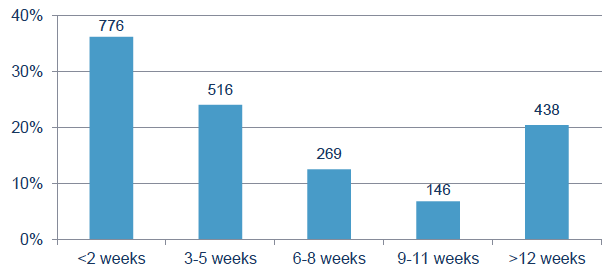
2.5 Time in WHSS
2.5.1 Time between enrolment and entry assessment
Among the available sample (11,708), on average there were 5.2 ( SD 9.8) days between the day that cases enrolled into the service and the day they were assessed. The majority (79%) of cases were assessed within 7 days of their enrolment: 4,232 (36.2%) of cases had their assessment on the same day as their enrolment; 4,994 (42.7%) were assessment between 1 to 7 days after being enrolled. 19.5% were assessed between 8 and 30 days after enrolment. A small minority (178 cases, 1.5%) were assessed between 30 and 89 days after enrolment, while this was over 90 days for 19 cases (0.2%).
The waiting time is longer for the cases who were at work at enrolment (5.5 [ SD 10] days) than those cases who were on sick leave (4.4 [ SD 9 days]) (p<0.001).
2.5.2 Intervention time (entry assessment to discharge)
Of the 7,022 cases that completed at least some of the discharge paperwork, data on the duration in the programme are available for 7,008 where the discharge date is after the assessment date. (Discharge dates prior to the assessment data are considered erroneous and not included). Of these, the average intervention time was 121.0 days ( SD 81.1) days.
The duration of cases in the programme is shown in Table 8. The majority (83%) are discharged within 6 months of their entry assessment; with 42% being discharged within 90 days and 41% being discharged between 91 and 180 days. Overall, 2% of cases were in the programme for more than a year.
Table 8: Duration in programme (entry assessment to discharge) (N=7,008)
| 0 days |
0.3% |
|---|---|
| 1 - 30 days |
3.8% |
| 31 - 90 days |
38.3% |
| 91 - 180 days |
41.0% |
| 181 - 365 days |
14.6% |
| Over 365 days |
1.8% |
Contact
There is a problem
Thanks for your feedback